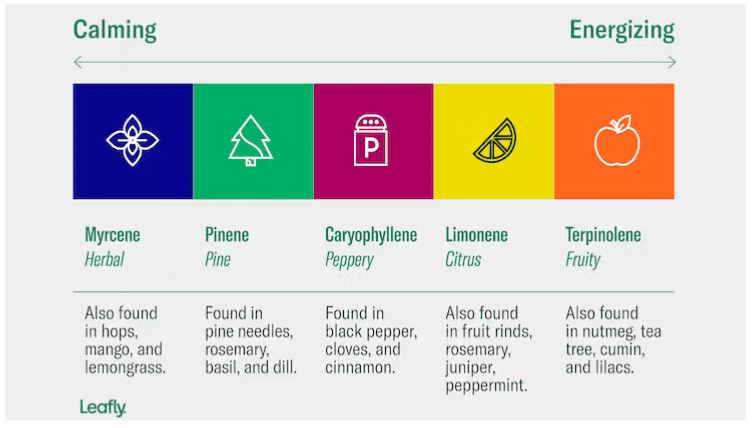Terpene Guide
Cape Cod Cannabis offers our Terpene Guide to help explain what a terpene is, where it comes from and how it interacts with other compounds to form the entourage effect along with the potential benefits.
What are Terpenes?
Terpenes are a large and diverse class of organic compounds produced by a variety of plants, including cannabis, conifers, and citrus trees. They are responsible for the distinctive flavors and aromas of many plants and have been used in traditional medicine for their potential therapeutic effects. In plants, terpenes serve several functions, including attracting pollinators and repelling predators.
In the context of cannabis, terpenes are often associated with the plant’s aromatic profile, commonly referred to as the “terpene profile” or “terpene profile.” Cannabis strains can have different terpene profiles, contributing to the unique scent and flavor of each strain. Some common terpenes found in cannabis include:
- Myrcene: Known for its earthy and musky aroma, myrcene is believed to have relaxing and sedative effects. It’s also found in hops, mangoes, and lemongrass.
- Limonene: This terpene has a citrusy scent and is found in citrus fruits. Limonene is associated with potential mood-enhancing and stress-relieving effects.
Pinene: As the name suggests, pinene has a pine-like aroma. It’s found in pine trees and is believed to have anti-inflammatory properties. There are two types of pinene: alpha-pinene and beta-pinene.
Linalool: Linalool has a floral scent and is present in lavender, mint, and cinnamon. It is associated with potential relaxing and anti-anxiety effects.
Humulene: With an earthy and woody aroma, humulene is found in hops, sage, and ginseng. It is sometimes considered to have anti-inflammatory properties.
Caryophyllene: This terpene has a spicy and peppery aroma and is found in black pepper, cloves, and cinnamon. Caryophyllene is unique because it can also interact with cannabinoid receptors in the body’s endocannabinoid system.
Terpenes are not unique to cannabis; they are present in a wide range of plants and contribute to the overall sensory experience of various fruits, flowers, and herbs. In addition to their role in aroma and flavor, terpenes are being studied for their potential therapeutic properties, both individually and in conjunction with cannabinoids like THC and CBD.
Where do Terpenes come from in the cannabis plant?
Terpenes in the cannabis plant, like in many other plants, are produced in the glandular trichomes. Trichomes are small, hair-like structures that are most concentrated on the flowers (buds) of the cannabis plant, but they can also be found on other parts of the plant, including the leaves and stems.
There are more than 100 different terpenes that have been identified in cannabis. Each cannabis strain has a unique combination and concentration of terpenes, contributing to its distinct aroma, flavor, and potentially influencing its effects. While some terpenes are more commonly found in certain strains, the overall terpene profile can vary widely.
The glandular trichomes contain resin glands that produce a mixture of cannabinoids (such as THC and CBD) and terpenes. Terpenes are synthesized in these glands through the same metabolic pathways that produce cannabinoids. The combination of cannabinoids and terpenes in the resin glands gives cannabis its distinctive aroma, flavor, and potential therapeutic effects.
During the flowering stage of the cannabis plant’s life cycle, trichome production increases, and the terpene content becomes more prominent. As the plant matures, the concentration and composition of terpenes can change. Factors such as genetics, growing conditions, and environmental factors also influence the terpene profile of a cannabis strain.
Harvesting and processing methods can impact the preservation of terpenes. Some methods, such as low-temperature drying and careful handling of the plant material, are employed to retain the maximum terpene content in the final product. Additionally, the extraction of essential oils from cannabis, often used in the production of concentrates and extracts, can isolate and concentrate terpenes for various applications.
It’s worth noting that terpenes are not unique to cannabis; they are found in many plants and serve various ecological functions. The diversity of terpenes contributes to the wide range of aromas and flavors found in different cannabis strains.
What is the Entourage Effect?

The entourage effect is a concept in cannabis pharmacology that suggests that the combination of various compounds found in the cannabis plant, including cannabinoids and terpenes, works together synergistically to produce a collective therapeutic effect that is greater than the sum of their individual effects. In other words, the interaction between different components of the cannabis plant may enhance or modify the overall therapeutic outcomes.
The entourage effect is often used to explain why whole-plant extracts or full-spectrum cannabis products, which contain a broader range of cannabinoids and terpenes, may have different or more pronounced effects compared to isolated compounds (e.g., pure THC or CBD). Proponents of the entourage effect argue that the presence of multiple cannabinoids and terpenes in their natural ratios may create a more balanced and effective therapeutic outcome.
Here are some key components involved in the entourage effect:
1. Cannabinoids: THC (tetrahydrocannabinol) and CBD (cannabidiol) are the most well-known cannabinoids, but there are many others present in the cannabis plant, each with its potential effects.
2. Terpenes: These aromatic compounds contribute to the flavor and scent of cannabis and may have their own therapeutic properties. The combination of specific terpenes with cannabinoids is thought to influence the overall experience and effects.
3. Flavonoids: These are another group of compounds found in cannabis (as well as in many other plants) that have antioxidant and anti-inflammatory properties. Flavonoids may also contribute to the entourage effect.
Research on the entourage effect is still ongoing, and the mechanisms behind how different compounds interact in the body are complex and not fully understood. While some studies support the idea of the entourage effect, more research is needed to determine its extent and significance in different therapeutic applications.
It’s important to note that individual responses to cannabis can vary, and what works well for one person may not have the same effects for another. The entourage effect is a topic of interest in the field of medical cannabis, as researchers and clinicians seek to optimize therapeutic outcomes and understand the complexities of the plant’s chemical composition.
Who coined the phrase “Entourage Effect”?
The term “entourage effect” was coined by Israeli scientists Raphael Mechoulam and S. Ben-Shabat in 1998. Raphael Mechoulam is a renowned organic chemist who is often referred to as the “father of cannabis research.” Mechoulam, along with his colleague S. Ben-Shabat, published a paper in the European Journal of Pharmacology titled “An entourage effect: inactive endogenous fatty acid glycerol esters enhance 2-arachidonoyl-glycerol cannabinoid activity.”
In this seminal paper, Mechoulam and Ben-Shabat proposed the concept of the entourage effect, suggesting that the combined action of various compounds in the cannabis plant, including cannabinoids and terpenes, might produce a more significant and synergistic effect than the effects of individual compounds in isolation. They specifically explored how certain fatty acid glycerol esters enhanced the activity of the endocannabinoid 2-arachidonoyl-glycerol.
The entourage effect has since become a widely discussed and researched concept in the field of cannabis pharmacology. It has implications for understanding the therapeutic potential of whole-plant cannabis extracts, where multiple cannabinoids and terpenes are present in their natural ratios. The idea is that these compounds work together to create a more balanced and effective therapeutic outcome compared to isolated cannabinoids or synthetic compounds.
Popular Terpenes

Click on the terpenes below to see their individual Aromas, Entourage and potential benefits.
Bisabolol
Aroma: Chamomille
Entourage: Anti-Inflammatory, Anti-Microbial, Pain Relief, Anti-Irritant, Stress and Anxiety Relief
Borneol
Aroma: Ginger, Rosemary, Sage, Thyme
Entourage: Anti-Inflammatory, Pain Relief, Stress and Anxiety Relief
Camphene
Aroma: Cintronella, Rosemary, Sage, Fir, Neroli Blossom
Entourage: Antioxidant, Antibacterial, Anti-Fungal, Respiratory Relief, Anti-Congestion
Caryophyllene
Aroma: Black Pepper, Cinnamon, Hops, Oregano, Cloves
Entourage: Anti-Inflammatory, Antioxidant, Stress and Anxiety Relief, Pain Relief, Anti-Fungal
Eucalyptol
Aroma: Eucalyptus, Tea Tree, Sweet Basil, Cardamom, Bay Leaves
Entourage: Anti-Inflammatory, Antioxidant, Anti-Fungal, Stress and Anxiety Relief
Geraniol
Aroma: Peach, Lemon, Blackberry, Coriander, Rose Oil
Entourage: Anti-Inflammatory, Antioxidant, Antibacterial, Anti-Fungal, Neuroprotectant, Anti-Cancer
Guaiol
Aroma: Tea Tree, Nutmeg, Apple, Cypress, Pine, Lilac
Entourage: Anti-Inflammatory, Antioxidant, Antibacterial, Pain Relief
Humulene
Aroma: Hops, Basil, Ginger, Clove, Ginseng, Sage
Entourage: Anti-Inflammatory, Antibacterial, Antioxidant, Appetite Suppressant, Anti-Tumor
Limonene
Aroma: Lemon, Lime, Orange, Celery, Juniper, Citrus
Entourage: Stress and Anxiety Relief, Mood Elevation, Pain Relief, Antioxidant, Antibacterial, Digestion
Linalool
Aroma: Lavender, Sage, Birchwood, Sweet Orange, Coriander, Cilantro
Entourage: Decongestant, Anti-Inflammatory, Sedative, Stress and Anxiety Relief, Pain Relief, Anti-Epileptic, Anti-Psychotic
Myrcene
Aroma: Mango, Hops, Thyme, Lemongrass, Bay Leaves, Cardamom
Entourage: Anti-Inflammatory, Sedative, Relaxing, Pain Relief
Nerolidol
Aroma: Jasmine, Tea Tree, Lavendar, Lemongrass, Ginger
Entourage: Anti-Inflammatory, Antioxidant, Anti-Parasitic, Sedative, Stress and Anxiety Relief
Ocimene
Aroma: Mint, Kumquats, Orchids, Parsley, Basil
Entourage: Uplifting, Anti-Inflammatory, Antioxidant, Decongestant, Antibacterial, Anti-Convulsant
Pinene
Aroma: Pine Trees, Rosemary, Dill, Ginger
Entourage: Anti-Inflammatory, Memory Aid, Pain Relief, Stress and Anxiety Relief, Anti-Microbial, Anti-Depressant
Pulegone
Aroma: Catnip, Peppermint, Rosemary, Ginseng, Spearmint
Entourage: Stress and Anxiety Relief, Pain Relief, Sedative, Anti-Inflammatory
Terpinolene
Aroma: Tea Tree, Cumin, Nutmeg, Apple, Lilac, Mint
Entourage: Antibacterial, Antioxidant, Sedative (on its own), Energizing (when paired with THC), Gastrointestinal Aid
Shop High Testing Cannabis Flower
Please visit our Intro to Cannabis page for more information.
IMPORTANT INFORMATION ABOUT CANNABIS:
Marijuana and Marijuana Products have not been analyzed or approved by the FDA, therefore there is limited information on side effects. There may be health risks associate with using marijuana or marijuana products. All marijuana and marijuana products should be kept away from children.
Under M.G.L. c90, §24 it is illegal to drive or operate machinery under the influence of marijuana.
We always recommend speaking with a physician regarding dosage. For consumers who are new to cannabis er recommend starting with smallest dosage according to package directions and allowing sufficient time to pass to allow effects to be felt, based on the method of consumption or application.
Tolerance, dependence and withdrawal have not been researched therefore please consume marijuana and marijuana products at your now risk.
If you or someone you know is exhibiting signs or symptoms of substance abuse please contact the Massachusetts Substance Abuse Helpline at 800 327 5050 for further assistance.
Consumer may not sell marijuana to any other individual, doing so may impose a fine and/or imprisonment; likewise registered qualifying patients may not distribute marijuana to any other individual, and that they must return unused, excess, or contaminated product to the RMD from which they purchased the product, for disposal.
For information regarding penalties for possession or distribution of marijuana in violation of Massachusetts law Please refer to M.G.L. c90, §13.
For additional educational materials please refer to our website www.CapeCodCannabis.com
Please consume cannabis products responsibly.
Cannabis is for use only by adults 21 years of age or older. All information contained herein and, on our website, www.capecodcannabis.com, is for educational purposes only. None of this information should be interpreted as medical or treatment advice for any person or condition. Always consult with a licensed physician in all maters regarding your health.






















